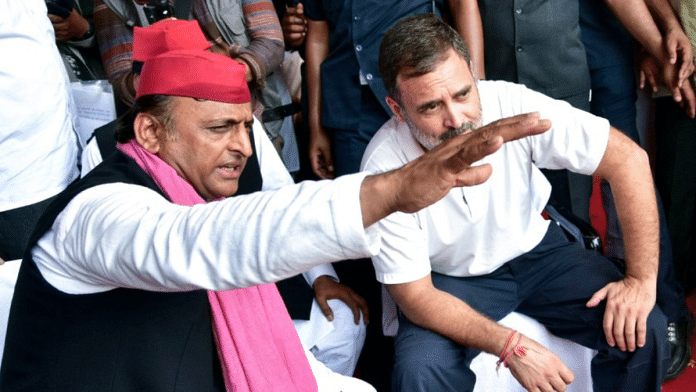Thank you dear subscribers, we are overwhelmed with your response.
Your Turn is a unique section from ThePrint featuring points of view from its subscribers. If you are a subscriber, have a point of view, please send it to us. If not, do subscribe here: https://theprint.in/subscribe/
The true strength of democracy lies in two-way communication between the people and their representatives. Yet, the social media profiles of India’s top leaders suggest that this dialogue has increasingly become one-sided. Leaders want millions to follow them, read their posts, and share their messages. But when it comes to following back or listening to citizens, the picture is starkly different.
To illustrate this, consider the recent figures from the social media platform X:
| Politicians | Party | X
(Follower) |
X
(Following) |
| Narendra Modi | BJP | 109M | 2678 |
| Dharmendra Pradhan | BJP | 2M | 1759 |
| Asaduddin Owaisi | AIMIM | 3.2M | 1489 |
| Shashi Tharoor | INC | 8.4M | 1203 |
| Tejashwi Yadav | RJD | 5.4M | 1055 |
| Nirmala Sitharaman | BJP | 5.6M | 787 |
| Rajnath Singh | BJP | 24.7M | 647 |
| J.P.Nadda | BJP | 3.8M | 551 |
| Nitin Gadkari | BJP | 15.4M | 525 |
| Rahul Gandhi | INC | 28.2M | 372 |
| Priyanka Gandhi | INC | 5.9M | 370 |
| Arvind Kejriwal | AAP | 27.6M | 242 |
| Yogi Adityanath | BJP | 14.4M | 58 |
| Akhilesh Yadav | SP | 20.7M | 24 |
| Dimple Yadav | SP | 1.1M | 3 |
| Mayawati | BSP | 3.7M | 1 |
(Source: The above figures are taken from X (as of September 17, 2025)
These figures clearly show that while leaders command followers in the millions, the number of accounts they follow is minimal. Rahul and Priyanka Gandhi follow barely 370 accounts each, despite having millions of supporters. Mayawati appears the most disconnected, following just one account — and that too an outdated, inactive handle (@Support) — which highlights her minimal engagement.
Narendra Modi has one of the largest digital footprints among leaders, with significant visibility, though his engagement too remains selective. Asaduddin Owaisi reflects attentiveness and responsiveness, underlining his effort to remain connected in online conversations. Shashi Tharoor, with his blend of popularity and intellectual appeal, showcases conscious engagement with citizens in a manner that elevates discourse. Tejashwi Yadav also deserves mention for his relatively greater openness to interaction, which sets him apart from many of his contemporaries. Collectively, these leaders demonstrate awareness of social media’s democratic potential, but they stop short of turning it into a real two-way communication channel.
Across parties, leaders remain highly active on social media, but their participation is largely limited to broadcasting their views. In states like Uttar Pradesh, prominent figures such as Yogi Adityanath, Rahul Gandhi, Priyanka Gandhi, Akhilesh Yadav, Dimple Yadav, and Mayawati fall significantly behind in this regard.
Ignoring the Comment Section
The follower–following ratio is one aspect, but an even more telling sign is how leaders largely ignore the comment sections of their posts. Each tweet, post, or video draws thousands of comments—citizens expressing opinions, asking questions, or offering suggestions. Yet, leaders rarely acknowledge them, let alone respond.
As a result, citizen participation on social media is vibrant and active, but from the leaders’ side, the dialogue remains almost silent. The democratic ideal of two-way communication is weakened: citizens keep listening, but their voices are not being heard.
Neglecting Party Workers and Intellectuals
This trend is not limited to the public at large. Leaders also refrain from following their own party workers, office-bearers, or even eminent intellectuals from various fields. The message is clear: communication within parties is just as one-sided.
Grassroots workers—the backbone of political parties—feel ignored when their efforts or ideas fail to reach the top. This neglect breeds frustration and weakens their loyalty. The consequences are visible on the ground: reduced enthusiasm and commitment in electoral campaigns. The same holds true for intellectuals and experts, whose voices once formed an integral part of democratic dialogue but now find little space in leaders’ echo chambers.
“The Throne Has Ears, Not Eyes”
An old saying in politics goes, “The throne has ears, not eyes.” Power often listens to a select few while avoiding seeing the ground reality. Social media had given leaders the “eyes” they previously lacked—a chance to directly observe people’s problems, opinions, and reactions.
Unfortunately, the numbers suggest leaders are unwilling to use this opportunity. They continue to rely on “ears”—flatterers, fan clubs, and kitchen cabinets—rather than directly seeing or engaging with the public. Citizens are constantly speaking in the comment sections, but leaders show neither the courtesy nor the sensitivity to listen. Thus, social media has been reduced to yet another tool of propaganda, rather than a medium for democratic dialogue.
This growing distance is dangerous for democracy. Leaders expect citizens to follow them, but they shy away from following or listening to citizens, party workers, and intellectuals. If this attitude persists, democratic dialogue will weaken, grassroots workers will grow disillusioned, and public anger may eventually translate into political setbacks for these leaders.
Democracy cannot be sustained by merely amassing followers. Its real strength lies in leaders choosing to follow back—not just on social media, but in ideas, dialogue, and genuine engagement. Only then can trust deepen and democracy grow stronger.
Dr. Anvveshan Singh is assistant professor of Journalism at DDU Gorakhpur University,also a noted political critic, known for his insightful analysis of politics, media, and public discourse.
These pieces are being published as they have been received – they have not been edited/fact-checked by ThePrint.


